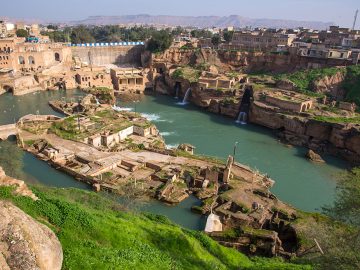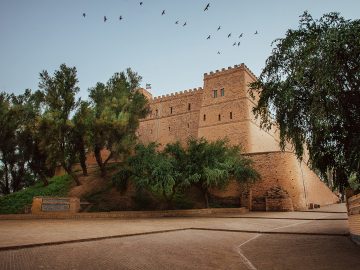Khuzestan province, with an area of 64,055 square kilometers, is the tenth-largest province of Iran. It borders Lorestan, Chaharmahal & Bakhtiari, Kohgiluyeh & Boyer-Ahmad, Ilam, Bushehr, the Persian Gulf, and Iraq. The province includes 27 counties, of which Ahvaz (center), Dezful, Andimeshk, Izeh, Behbahan, and Hendijan are the largest ones. The residents of Khuzestan are from various ethnic groups with their own language mainly including Arab, Lur, and Fars.
The Zagros Mountains cover the northern areas of the province, while the southern regions are mostly covered by hills and plains. Khuzestan has mountainous and arid-desert climates in highlands and the lower regions, respectively.

The land of Khuzestan was somehow similar to the land of the Elam (Elamites) Empire (2700- 539 B.C.) and what makes them distinctive is the ancient city of Susa as an indication of the glory. Shapur I, one of the kings during the Sassanid Empire (224-651 A.D.), built the famous Band-e Shushtar and Gundeshapur city.
The latter was an international reputed educational center with scholars from Greece, Egypt, India, and Rome. After the seizure of Khuzestan by the Arabs following their invasion of Iran in 641 A.D., the region was ruined for a while. Ahvaz as one of the oldest cities in Iran was called “Hormoz Ardeshir” in ancient times. The city experienced its boom during the reign of Ardeshir, the first king of the Sassanid Empire following its selection as the capital of the Susiana (Khuzestan), while Susa was also a candidate.
When invaded by the Arabs, they entitled Ahvaz “Soq-Al-Ahvaz”, meaning the Khuzi market (Hozi). The Khuzi was a local ancient tribe of warriors that influences the name of the province. When the king Nasser-al-Din Shah of Qajar Dynasty (1796-1925) took the throne, a comprehensive peace was brought to the area and by his order, Naseri Port was built so as to develop the shipping industry in the Karun River; it was built next to old Ahvaz. However, Khuzestan suffered irreparable damages during the eight-year Iran-Iraq war from 1980 to 1988.
The significant natural attractions of the province include Karun, Karkheh, and Dez Rivers, attracting a significant number of domestic tourists to Khuzestan province. Shrine of Khezr, Ashkoft Kul-e Farah (Izeh), Shahsavar ancient site, and Shevi Waterfall are among other prominent attractions of Khuzestan. The religious rituals of the Mandaeans who follow John the Baptist and live along the Karun River are also one of the unique tourist attractions.
Importantly, the three sites of Chogha Zanbil holy temple from the Elamite civilization, the ancient city of Susa, and the Shushtar Hydraulic Structures have been registered as the UNESCO World Heritage Site.
Khuzestan handicrafts include carving on gold and silver, woodcarvings, handmade fabric, mat and Abba (a kind of religious costume) weaving. Different kinds of dates and southern fishes are souvenirs of the province, while fish and shrimp are the main ingredients of most Khuzestani dishes due to the closeness to the sea. Samosa, Falafel, Qaliyeh Mahi, Fried Shrimp, Shushtari rice and Hariseh are the most notable local foods.


